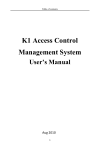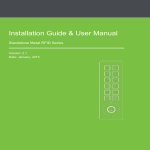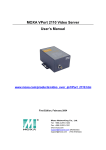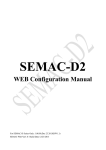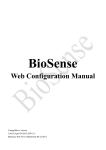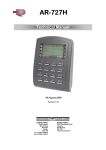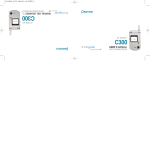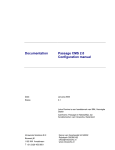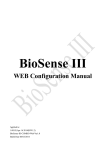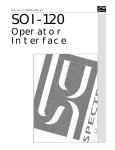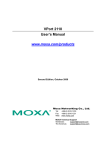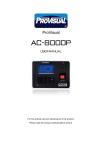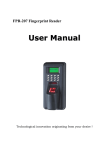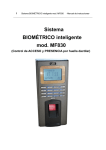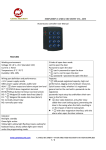Download Dear Customer: Thank you for purchasing our
Transcript
Dear Customer: Thank you for purchasing our product, MF850 Fingerprint access control! To fully enjoy the benefits of this product, please read instructions included in this manual carefully. Version: Ver 1.0 (Jan, 2010) All images in this manual are for reference, and should be subject to the actual product. Because there might be print errors, inaccurate descriptions in this Manual, and the Manual might be updated, this manual will be subject to change. In case any modifications of this manual occur, the updated version will include these changes, without any notice. Guarantee on Human Rights and Privacy We hereby guarantee that fingerprint access controls supplied by our Company only acquire fingerprint minutiae and do not preserve fingerprint privacy. In addition, the fingerprint minutiae cannot be restored to the original fingerprint images. Therefore, your human rights will not be violated. Under no circumstances shall we, the provider of the equipment, be liable to any direct or indirect consequences arising out of or in connection with our equipment. In the event of any disputes with the user on human right copying or privacy. Please communicate with your employer. Fingerprint Access control User’s Manual Table of Contents Table of Contents Chapter One Product Overview 1.1 System Overview ............................................................. - 3 1.2 Parameters ........................................................................ - 4 1.3 Hardware Installation ....................................................... - 6 1.4 Appearance Description ................................................... - 7 1.5 Interface Explanation ....................................................... - 8 1.6 Fingerprint Placement Guide ........................................... - 9 Chapter Two Basic Function 2.1 Keyboard ........................................................................ - 10 2.2 Menu .............................................................................. - 11 2.2.1 Menu structure ............................................................... - 11 Chapter Three Operation Flow 3.1 Initial Use ....................................................................... - 14 3.1.1 Hardware Installation ..................................................... - 14 3.1.2 User Registration ........................................................... - 14 3.1.1. Delete Registered Data .................................................. - 18 3.1.2. Settings Relating to Access Control ............................... - 19 3.1.5 Attendance/Access Control Operation ........................... - 22 3.1.6 Record Searching ........................................................... - 24 3.2 Daily Use ....................................................................... - 24 Chapter Four Management Operation 4.1 Enter Management Menu ............................................... - 24 4.2 Data Management .......................................................... - 24 4.3 Setting ............................................................................ - 25 4.4 Access Control Setting ................................................... - 30 4.5 System Information ........................................................ - 33 4.6 Shortcut Key Setting ...................................................... - 33 Chapter Five MF-10 Description 5.1 Product Overview .......................................................... - 35 5.2 Instruction for Connection of Access Control and MF-10- 35 -1- Fingerprint Access control User’s Manual 5.3 MF-10 Operating Instruction ......................................... - 36 Technical Support Appendix -2- Fingerprint Access control User’s Manual Chapter One Product Overview 1.1 System Overview A fingerprint Access control combines functions of access control and time and attendance management. It provides safe access control function as well as convenient time attendance management. A fingerprint access control management system consists of a fingerprint access control terminal (hereinafter called access control), electronic lock controller, electronic lock, door sensor, alarm bugle, button, door bell, power, PC and access control management software. The access control is responsible for user’s information registration and daily identification of entry in and out. When used as access control, it allows the user to open the door by pressing the registration finger, without using a key. When used for both access control and time attendance, it allows that only registered fingerprints are required for these purposes. The access control system is designed to configure parameters, back up data of the equipment, and download access record. It also conducts data statistics and processing according to the time and attendance rules set forth by the administrator, generates various statistical reports, and enquires in and out record logs. As a result, it can fulfill the functions of access control, and time attendance. The access control can operate in off-line mode, without being connected with the management software. For an access control used without the management software, functions of user validation period and real-time monitoring are not available. There are mainly two communication modes between the access control terminal and access control management system, namely, RS485, TCP/IP. The system configuration is shown in the following diagram: -3- Fingerprint Access control User’s Manual Controlled Lock Power Electric Lock Door Sensor Access Control Alarm Bell Push Button Schematic for Installation of Access Control TCP/IP、RS485 Outdoor Indoor 1.2 Parameters Description MF850 fingerprint access control Working voltage 12V Static working current Dynamic current Relay contact current 250MA 3A 120VAC/28VDC 2.4’ TFT color screen LCD Operation temperature Dimension (mm) Relative 150MA operation humidity 0℃-- +45℃ 185 X 80 X 35 20%--60% Fingerprint sampler High-hardness optical fingerprint sampler Keyboard 20 tact switch Main board Smart KM dual-core low-consumption structure Core algorithm HAS 8.0 FRP ≤1% -4- Fingerprint Access control User’s Manual FAR ≤0.0001% Reaction time ≤1s Working mode Offline/ inline Sensitivity level setting 1:N/1:1 Fingerprint-password-card, fingerprint + Identification mode password, fingerprint + card, card + password, card + fingerprint + password Capacity of fingerprint Capacity of management record Capacity of in and out records Communication mode 1, 500 1,000 60, 000 RS485, TCP/IP Language display Simplified/ Traditional Chinese, English Vocal instruction Five parts of high quality voice Name display Long name display (in Chinese/ English) Time group 30 groups Time section 50 sections Alarm Alarm for removal prevention, alarm for overtime opening, alarm for tamper resistance, alarm for external input points Fire fighting Available blocking Threatening alarm Available Exit button Available Wigand interface Supports standard 26/34 input and output Tamper resistance Available Real-time monitor Available Validity Available -5- Fingerprint Access control User’s Manual Extension module ID / IC / HID Bell ring function 20 groups of rings Doorbell interface Available 1.3 Hardware Installation Installation Procedure The access control is of mounting type. The steps for installation are as follows: 1) Positioning: Position four holes on appropriate wall according to iron board’s holes. 2) Drilling: Drill four holes using screws (supplied with terminal) 3) Fixing iron board: Put an iron board on appropriate place of the drilling area. And then fix the iron plate firmly by beating the screws. 4) Suspension: Hang up the terminal on the iron board (with the bottom 1.4m from the ground). 5) Powering on: Connect the equipment as per the reference connection diagram, and power on the equipment. 6) Connecting to the computer: The product may be connected to the computer using RS485 or TCP/IP. Select a communication mode for the access control and management computer. Then, set up communication parameters on the access control (See Section 4.3). Connect the access control and computer with communication cables. Then, install the management software on the management computer, and set related communication parameters, which must be the same with the parameters on the access control. (For operating modes, see the User’s Manual for Reference Software). Notices for Installation: 1) Environment: It is recommended that the access control be installed indoor. If used outdoor, the equipment must be protected against strong rays and rains. It is also recommended a sunshade and heat dissipation device be used in summer, and thermal insulation facilities be used in winter. 2) If RS 485 communication cables are used, the cables must be double-core shielded wire. Avoid using network cables. Do not connect the equipment to strong power (220V). The maximum communication distance is 1100m. Additional repeaters must be provided for communication distance greater than 800m, so as to ensure communication reliability. For RS485 communications, it is recommended that Baud -6- Fingerprint Access control User’s Manual rate be set to 19,200, because the communication reliability and transmission distance increase when Baud rate reduces. But the transmission speed falls when the Baud rate reduces. 3) Wiring for the exit button should not be too long, instead, it should be close to the terminal as applicable. 4) The controlled lock power should be close to the terminal and electronic lock as applicable. 5) The relay can control the electronic lock directly and the maximum withstand current is DC 30V/2A. 1.4 Appearance Description -7- Fingerprint Access control User’s Manual 1.5 Interface Explanation (1) RJ45 communication interface (8P-2.54) definition PIN Definition Description 7 RS485+ 485+ 8 RX485- 485- (2) Access control interface 1 (12P interface on the left of the back) definition. P IN Definit Description ion 1 BELL2 Doorbell interface 2 2 BELL1 Doorbell interface 1 3 P2 External signal input 2 4 P1 External signal input 1 5 GND Power supply grounding 6 D1_IN Wigand data 1 input 7 D0_IN Wigand data 0 input D1_O Wigand data 1output D0_O Wigand data 0 output 8 UT 9 UT -8- Fingerprint Access control User’s Manual 1 GND Power supply grounding COM_ MF-10 interface COM_ MF-10 interface 0 1 1 B 1 2 A (3) Access control interface 2 (12P interface on the right of the back) definition. 1 +12V Power supply (+12V) 2 GND Power supply grounding 3 T_ALM_OUT Output terminal of hidden alarm control 4 T_ALM_IN Input terminal of hidden alarm control 5 ALM_OUT Output terminal of exposed alarm control 6 ALM_IN Input terminal of exposed alarm control 7 OPN_S Door lock switch 8 OPN_K Exit button 9 GND Power supply grounding 10 NC Normally closed terminal of lock sensor 11 COM Common terminal of lock sensor 12 NO Normally open terminal of lock sensor 1.6 Fingerprint Placement Guide When installation of the terminal is completed, the fingerprint will be registered first, which is followed by validating operation. The recommended finger for registration is the forefinger and middle finger. -9- Fingerprint Access control User’s Manual Correct Too perpendicul ar Too deflective Too oblique Too low Correct pressing manner: Correct finger placement method: Press with your finger on the fingerprint gathering window. Make sure the fingerprint’s centre is aligned to the centre of the gathering window as much as possible. Finger press method is shown as the following figure. Chapter Two 2.1 Basic Function Keyboard The configuration of the keyboard is shown in the following figure. The function is described as follows: ESC:To perform EXIT or CANCEL; OK: To confirm; MENU: To access menu management; ▲ or ▼: Scroll-up/ down button for menu operation; 0…9: To input numbers; F1-F4: Shortcut keys (The definition is given in Section 4.6) - 10 - Fingerprint Access control User’s Manual Menu For the access control, you can use function keys and numerical keys to perform flexible menu selection, keyboard input and various settings. The level-1 menu includes three categories: record management, setting and system information. Each menu consists of different subordinate level-2 and level-3 menus to perform corresponding operations. 2.2.1 Menu structure 2.2 The constitutions of the level 1 menu are: 1) Data management: To register and delete the fingerprints, passwords and data on inductive card for users or administrators, and all records, and to set safe value of algorithm. 2) Setting: To set system parameters for the terminal. 3) Access control setting: To set parameters for the terminal. 4) System information: To examine the information recorded in the terminal. The structure of level 1 menu is shown in the figure above. Only a super administrator is entitled to have access to ―Setting‖ and ―Terminal Setting‖ options in the level 1 menu. An ordinary administrator is granted access to only a part of level 2 menu under ―Data management‖ (level 1 menu) and ―System information‖ of level 1 menu. The structure of level 1, 2 and 3 menus are described as follows: 2.2.12. Setting Menu Select ―Data Management‖ using ▲/▼ in level 1 menu. Then press ―OK‖ to access the level-2 menu, which has totally 5 items. Move the cursor using ▲/▼ to select desired option among menus of the same level. Press OK to access the sub-menus of the selected menu. Press ESC to return to the higher-level menu. Level-4 menu is contained in the ―Super Administrator‖ and ―Registered Administrator‖, which are level 3 menus. The content of the menu is identical with the level-3 menu under ―User Registration‖. The structure is shown below: - 11 - Fingerprint Access control User’s Manual Password User Level 1 menu Level 3 menu Level 2 menu Note: The ID cards are not included in the standard functions, and must be used with an external reading head. Only the super administrator is entitled to access the following items under the level 3 menu: ―super administrator‖, ―registered administrator‖, ―1:1 safety setting", ―1:N safety setting‖, and ―delete all records‖. In addition, when executing ―Delete registered data‖, the super administrator can only delete the user’s registered data and data of an administrator belonging to the same level. 2.2.12. Setting Menu In the level 1 menu, when the cursor is at ―Setting‖, click ―OK‖ to enter the level 2 menu. This menu has three setting items, and there are corresponding sub-items (level 3 menus) under the level 2 menu. The structure is shown in the following figure. - 12 - Fingerprint Access control User’s Manual Total No. of administrators Language Time setting Time format Vocal language System Setting Sensitivity adjustment Restore factor setting Machine No. Baud rate Setting Port No. Communication password Communication setting IP address Level 1 menu Subnet mask Default gateway Outgoing and incoming records alert Management records alert Record setting Level 2 menu Level 3 menu Note: Only the super administrator is entitled to enter the following items under the level 2 menus: ―system setting‖, ―communication setting‖ and ―record setting‖. 2.2.13. Access Control Setting Menus In the level 1 menu, when the cursor is at ―Access Control Management‖, click ―OK‖ to enter the level 2 menu. This menu has 9 setting items. The structure is shown in the following figure. Delayed door opening Delayed door opening alert Illegal door opening alert Time section setting Access control setting Level 1 menu Time group setting Level 2 menu User control setting Threatening alarm Threatening action Wigand format Note: Only the super administrator is authorized to enter the level 2 menu under - 13 - Fingerprint Access control User’s Manual ―Access Control Management‖. 2.2.14. System Information Menu User Administrator registration Fingerprint registration System information Proximity card No. registration Password registration Level 1 menu Level 2 menu Outgoing/incoming records Management records In the level 1 menu, when the cursor is at ―System Information‖, click ―OK‖ to enter the level 2 menu. This menu has 7 items. The menu structure is shown in the above figure. Chapter Three Operation Flow Initial Use 3.1 The initial using steps are as follows: Access control settings User registration and deletion Record searching Detail operation steps are as follows: 3.1.1 Attendance/access control in and out operation Hardware Installation For the detail installation steps and methods, please refer to Section 1.3. 3.1.2 User Registration The fingerprint access control has three registration identification methods: fingerprint, password and inductive card. Before using, users must be registered. When registering, each user must use an exclusive ID number. ID number is the Fig. 1 number of the user information in the management software corresponding to the data in the access control. Each ID number can be registered with 3 fingerprints, 1 group of - 14 - Fingerprint Access control User’s Manual password and one inductive card at most.ID number ranges 1- 65535.The standby interface of the access control is shown in Fig. 1: Fingerprint registration: Each user can register 3 fingerprints at most. In standby mode, press ―MENU‖ key, enter Menu Registration Fingerprint Registration Finger three times New Registration Data Management User Input ID Number Press Save, registration succeeds. The detail operation steps are as follows: Fig. 2 Fig.3 Fig. 2 ―MENU‖ key, the interface will Fig. be 3 displayed (as shown in Fig. 2). After pressing If a administrator has been registered, the interface is shown in Fig. 3. Before entering the menu, administrator verification must be done. For operating method, please see Section 4.1. Under the interface shown in Fig. 2, select ―Data Management‖, press ―OK‖ key, the display is shown in Fig. 4. Fig. 4 Fig.5 Select ―User Registration‖, Press ―OK‖ key to enter the registration type select interface (as shown in Fig. 5): After selecting ―Fingerprint Registration‖, press ―OK‖ key to enter the new registration interface (as shown in Fig. 6): Press ―OK‖ key, the display is shown in Fig. 7. If it is used for the first time, the default ID number is 00001, which can be changed manually. Input corresponding ID number, then press ―OK‖ key (as shown in - 15 - Fingerprint Access control User’s Manual Fig. 8): Fig. 6 Fig. 7 Press with the same finger for three times according to the instruction on the interface, the registration will be successful (as shown in Fig. 9): Fig. 8 Fig. 9 Note: The last digit “0” in 00001-0 represents the first fingerprint, and so on. The third fingerprint will be taken as the threatened alarm fingerprint by default. Press ―OK‖ key to save the registration, After it is saved successfully, enter the interface for continuing registration (as shown in Fig. 10).If you press ―ESC‖ key, you will enter the back-up fingerprint registration interface (as shown in Fig. 11). For backup, input the registered ID number, use another finger to press for three times, and save it. If three fingerprints are not identical, failure will be prompted and re-registration will be required. When registering, if the system finds similar fingerprints, the registration will be rejected and ―The fingerprint is repeated‖ will be displayed. Fig.10 0 - 16 - Fig. 11 Fingerprint Access control User’s Manual Password registration: Each user can register one group of password besides 3 fingerprints. Under the interface shown in Fig. 5, select ―Password Registration‖, press ―OK‖ key, the display is shown in Fig. 12. Fig.12 Fig.13 Under the interface shown in Fig. 12, press ―OK‖ key to enter the input state for registering numbers. After inputting numbers (for example: 00001), press ―OK‖ key, the display is shown in Fig. 13. Input an identical password (1-4 digits) twice, press ―OK‖ key again to save it. Under the interface shown in Fig. 12, press ―ESC‖ key and input the registered ID number, a group of password can be registered for back-up or a registered password can be changed. Inductive card registration: Each employee can register 1 inductive card. Under the interface shown in Fig. 5, select ―Inductive Card Registration‖, press ―OK‖ key, the display is shown in Fig. 14: Fig.14 Fig.15 Press ―OK‖ key to enter the input state for registering numbers. After inputting numbers (for example: 00001), press ―OK‖ key, the display is shown in Fig. 15. After slotting the card, the card number will be filled in automatically. Press ―OK‖ key again to save it. Under the interface shown in Fig. 14, press ―ESC‖ key, input the registered ID number, a back-up inductive card can be registered or a new registration - 17 - Fingerprint Access control User’s Manual can be done. Tips: 1> If no administrator is registered, anybody can change settings of the access control. After administrators are registered, the management menu for changing settings of the access control cannot be entered without administrators’ verification. Therefore, it is recommended to register one administrator at least for managing data and settings of the access control. Enter [Administrator Registration] menu, and then register according to the instructions. The operating steps of administrator registration is the same as that of user registration. 2> After administrators are registered, non-administrator users (ordinary users) have the rights to do attendance or open the door only. 3> Administrators include two types: ―Super Administrator‖ and ―Registration Administrator‖. The ―Super Administrator‖ has the highest privilege and can conduct any operation on the access control. The ―Registration Administrator‖ has less right than the ―Super Administrator‖, and can only conduct operations such as ―User Registration‖, ―Delete Registration Data of Ordinary Users‖ and check ―System Information‖. If you lost your management privilege, you can cancel the administrator privilege through the management software of the access control. 4> When conducting administrator verification, ―Illegal Operation‖ will be prompted if registered information of ordinary users is input, the main menu cannot be entered to conduct setting operation. 5> When inputting an ID number or a password, you can omit the front zeros of the numbers and directly input the rear numbers. For example: If your ID is 00050, just input ―50‖. 6> When the registration is completed, verify your fingerprints to test the effectiveness of your fingerprint registration. The testing method: In standby mode, press your registered fingerprints. If the identification is successful, it means that your fingerprints are clear and the registration quality is good. If the identification is difficult to pass, it means that the quality of your registered fingerprint is not good enough or your registered fingerprint is not clear, new registration or registration with another finger are needed. 3.1.1. Delete Registered Data When an employee is resigned or the registration is error, the existing - 18 - Fingerprint Access control User’s Manual registration number should be deleted. Enter ―Menu‖ – ―Data Management‖ – ―Delete Registered Data‖, enter the data delete state (as shown in Fig. 16), input the registered number to be deleted (for example: 00001), press ―OK‖ to confirm (as shown in Fig. 17), press ―OK‖ key again to enter the interface for deleting, press ―OK‖ key directly to confirm and deletion will be done. Fig.16 Fig.17 Note: The last “0” of 0001-0 represents the first fingerprint, similarly, “1” and “2” represents the second and third fingerprint respectively. If it is “P”, it means that the password data will be deleted. If it is “C”, it means that the data of the inductive card will be deleted. Press up and down keys to select. 3.1.2. Settings Relating to Access Control After the user registration is successful, the user type should be selected through the [User Control Setting] menu. If ―Attendance‖ is selected, the user can do the attendance only, is not controlled by the privilege of the access control and does not have the right to open the door, and only the single identification mode can be used. If ―Access Control‖ is selected, the user is controlled by the privilege of the access control, and have the right to open and close the door. When using the access control function of the access control for the first time, settings such as ―Time Section‖, ―Time Group‖ and ―User Control Setting‖ must be set so that users can open and close the door normally. In standby mode, press ―MENU‖ key, select ―Access Control Setting‖, enter the access control setting interface, there are 9 setting items (as shown in Fig. 18 and Fig. 19). - 19 - Fingerprint Access control User’s Manual Fig.18 Fig.19 3.1.4.1 Time Section Setting Fifty in and out time sections of the access control can be set at most. In and out time from Monday to Sunday can be set for each time section. Under the interface shown in Fig. 18, select ―Time Section Setting‖, press ―OK‖ to enter the setting interface (as shown in Fig. 20). Press Up and Down keys to move the cursor to select the time section to be set, press ―OK‖ key to confirm. Use Up and Down keys to select the date to be set, press ―OK‖ key to move the cursor to the number, directly input numbers or press UP and Down keys to input the setting value, press ―OK‖ key to confirm, finally press ―ESC‖ key to exit and save it. Fig.20 Fig.21 3.1.4.2 Time Group Setting Set the time group of the access control. Users can be divided into different time groups. Thirty time groups can be set at most. Under the interface shown in Fig. 18, select ―Time Group Setting‖, press ―OK‖ to enter the setting interface (as shown in Fig. 21). Press Up and Down keys to select the time group to be set, press ―OK‖ key to confirm, and press ―OK‖ key, move the cursor to the setting item ―Multi-user‖, ―Time Group‖ or ―Identification Mode‖, and set each item. After setting is successful, press ―OK‖ key to confirm, and press ―ESC‖ key to exit and save. Description: 1> Multi-user: The setting range is 0 – 5. Each time group can be set with 5 users at most.―0‖ means that the multi-user function is not enabled. If ―1-5‖ is set, it means that the multi-user function is enabled, and the door will be opened only when users in - 20 - Fingerprint Access control User’s Manual the same time group sign in/out within 30 seconds, otherwise the door will not be opened. For example: If the value is set as ―3‖, the door will be opened only when 3 users in the same time group sign in/out within 30 sections. 2> Time section: Three different time sections can be set at the same time at most. If a user is not in the range of the set time section, the user cannot open the door. 3> Identification mode: Users of this group have 5 identification modes: Fingerprint – Password – Card, Fingerprint + Password, Card + Fingerprint, Card + Password, Card + Fingerprint + Password. Note: If the multi-user function is started, the multi identification mode is invalid for multi-user, multi-user can only use single identification mode. The input order for time section in 01-01-01 can be random. 3.1.4.3 User Control Setting Each user of the access control has an user control setting parameter. In the interface shown in Fig. 18, select ―User Control Setting‖, press ―OK‖ key, input the ID number to be set, press ―OK‖ key to enter the interface shown in Fig. 22, press Up and Down keys to select the parameter type to be Fig.22 set and press ―OK‖ key to confirm, press Up and Down keys to select parameters and press ―OK‖ key to confirm, and press ―ESC‖ key to exit and save. Setting item description: 1> Type: Include two parameters: ―Attendance‖ and ―Access Control‖. Users of attendance type are not controlled by the privilege of the access control and do not have the right to open the door, only the single identification mode can be used and attendance records will be produced. Users of access control type are controlled by the privilege of the access control and have the right to open and close the door. 2> Time group: Each access control user must be distributed to a time group and is controlled by the settings of the time group. There are 30 time groups can be selected. 3> Enable user time section: It is a switch setting. It controls whether the user uses his own time section or uses the time section of the time group. If ―Yes‖ is selected, the user uses his own time section and is not controlled by the time section of the time group. 4> Time section: The user’s own time section is the same as the time section of the - 21 - Fingerprint Access control User’s Manual time group. If ―Yes‖ is selected in the ―Enable User Time Section‖, this time section will be effective, otherwise the time section of the time group will be effective. Note: After it is enabled, the user still is controlled by the ―Multi-user‖ function of the user’s time group. If the user time section is enabled, it is recommended that the time group of multi-user is not enabled. 5> Enable user identification mode: It is a switch setting. It controls whether the user’s own identification mode is enabled or the identification mode of the time group is used. 6> Identification mode: It is the user’s own identification mode. If ―Yes‖ is selected in the ―Enable User Identification Mode‖, this identification mode is effective, otherwise this mode is not enabled. 7> Enable user valid period: User valid period must be set by the supporting software. If It is set as ―No‖, this function is disabled. If it is set as ―Yes‖, this function is enabled. 3.1.5 Attendance/Access Control Operation After user registration and access control settings are completed, the access control can be put into use. 1. Access control identification operation: According to parameter settings of identification mode of the access control, 7 identification modes can be used: Fingerprint, Password, Card, Card + Fingerprint, Card + Password, Fingerprint + Password and Card + Fingerprint + Password. 1) Fingerprint identification: Fingerprint identification can be done by two ways: 1: N identification: Press your fingerprint on the fingerprint sensor. If the identification succeeds, voice prompt (―Thank You‖) will be given out (as shown in Fig. 23). 1: 1 identification: Input your ID number on the keyboard, press your fingerprint when the Fig.23 screen is displaying ―1: 1 Fingerprint Confirmation‖. If the identification succeeds, voice prompt (―Thank You‖) will be given out. If the identification fails, voice prompt (―Please Re-press Your Finger‖) will be given out, meanwhile, the screen will display ―Please Re-press Your Finger‖. - 22 - Fingerprint Access control User’s Manual 2) Password identification: In standby mode, input your ID number, press ―OK‖ key – input password (1-4 digits) – press ―OK‖ to confirm. If the identification succeeds, voice prompt (―Thank You‖) will be given out. If the identification fails, the access control will sound ―Click‖, then the screen will display ―Please input again‖, you should conduct the identification again. 3) Inductive Card identification: In standby mode, put your inductive card close to the card slotting area of the access control. When your card is close enough to the card slotting area, the access control will conduct identification and give voice prompt (―Thank You‖). If the identification fails or your card has not been registered, the access control will sound ―Click‖, and then the screen will display ―Please input again‖. 4) Card + Fingerprint: In standby mode, slot your card and press your fingerprint (The registered number of your fingerprint must be the same as that of your card), If the identification succeeds, voice prompt (―Thank You‖) will be given out. 5) Card + Password: In standby mode, slot your card and input your password (The registered number of your password must be the same as that of your card), If the identification succeeds, voice prompt (―Thank You‖) will be given out. 6) Fingerprint + password: In standby mode, press your fingerprint and then input the corresponding password. If the identification succeeds, voice prompt (―Thank You‖) will be given out. 7) Card + Fingerprint + Password: In standby mode, slot your card, press your fingerprint, and input your password. If the identification succeeds, voice prompt (―Thank You‖) will be given out. 2. The identification on the external reader is conducted as follows: You can do attendance/access control identification on the access control. In addition, you can do the identification on the MF-10 and external inductive card reader which are connected with the access control. A. MF-10 identification operation: The MF-10 only supports 3 single identification ways such as Fingerprint, Password and Inductive Card. Even the access control is set with multi identification mode, the multi identification mode will automatically change to the single identification mode when identification is conducted on the MF-10. For detail identification operating steps, please refer to Section 5.3. - 23 - Fingerprint Access control User’s Manual B. Identification on the external inductive card reader is operated as follows: The inductive card reader only supports the single inductive card identification way. Even the access control is set with multi identification mode, the multi identification mode will automatically change to the single identification mode when identification is conducted on the inductive card reader. Its operating method is the same as the card slotting method of the access control and the MF-10.Please refer to Section 5.3. 3.1.6 Record Searching After you do attendance or go in/out, records will be saved on the access control. You can download and view the records through the supporting management software. For detail operating steps, please see the instruction of the supporting software. 3.2 Daily Use When you go in/out daily, you press your registered finger on the fingerprint sensor of the outdoor host machine. If the identification succeeds, the door will be opened and you can go in the door. When you go out the door, press the open button installed indoor (usually it is installed beside the door) to open the door. Chapter Four Management Operation 4.1 Enter Management Menu Under standby state, press MENU key to enter management menu (as shown in Fig. 2). If a administrator has been registered, it cannot be entered without administrators’ verification. Press MENU key, wait until the interface displays ―Administrator Identification‖, then perform identification. The identification method is the same as that for user identification. If the administrator identification failed (incorrect fingerprint, password or inductive card), ―Illegal Operation !‖ will be displayed and audible indication will be given out. The administrator identification must be re-conducted. If the identification succeeds, the management menu interface can be entered. 4.2 Data Management The ―Data Management‖ menu includes user registration, administrator registration, delete all data, delete all records and safety level setting. - 24 - Fingerprint Access control User’s Manual User registration: please refer to Section 3.1.2. Administrator registration: Under the data management interface (as shown in Fig. 4), select Administrator registration, press OK key to enter the selection interface of administrator right (as shown in Fig. 24). The registration method is the same as that of user registration. Fig.24 Fig.25 Delete all data: Please refer to Section 3.13. Delete all records: Enter Menu → Data management → Delete all records, press OK key , all records will be deleted (as shown in Fig. 25). Note: All records deleted from the above menu cannot be recovered, please be careful. Safety level setting: The detail functions are as follows: Setting items Setting Description value 1:1 Safety 1~50 setting For some users who are difficult to pass identification, this value can be lowered so as to improve identification pass rate. 1:N Safety setting Factory default 1~4 Based on all users’ safety level value, generally it is set as 1. 1:1 default as 27, 1: N default as 1 setting 4.3 Setting It is used to set system parameters. Press [MENU] → [SETTING] to enter the menu, including 3 items: system setting, communication setting and record setting (As shown in Fig. 26). - 25 - Fingerprint Access control User’s Manual Fig.26 Fig.27 System setting: Under the interface as shown in Fig. 26, select System setting, press OK to enter it, its interface is shown in Fig. 27.The detail description is as follows: Setting items Setting value Description Total 1~10 Set number the total number of of of administrators access administrators control The factory default is 5. Language ------- Including Simplified Chinese, Traditional Chinese English. The displays in and interface Simplified Chinese, Traditional Chinese and English. The factory default is Simplified Chinese. Time setting --------- Use the up and down arrows to select correct date numbers to set the date of the access control. Time format Year/Month/Day Press up and down arrows to or select the display order of the Month/Day/Year date of the access control. The factory default is ―Year/Month/Date‖. Voice prompt If you select ―Yes‖, you will Yes or No hear - 26 - voice prompt when Fingerprint Access control User’s Manual conducting identification. If you select ―No‖, you will not hear voice prompt when conducting identification. If the identification succeeds, the buzzer will sound ―Click, Click, Click‖ three times. If the identification fails, the buzzer will sound ―Click‖ one time only.The factory default is ―Yes‖. Sensitivity ------- adjusting If this item is selected, the access control will adjust the inductor to the best state. Restore to ------- factory setting After this item is selected, all data on the equipment will be cleared and all settings will be restored to factory default value. Please be careful when using this function. Communication setting: communication settings includes 7 items such as machine number, baud ratio, port number, communication password, IP address, subnet mask and default gateway. The detail description is as follows: 1> Machine number Setting Description value 1~255 Set the number of the access control Factory 1 setting Note: Machine number is the unique ID for the machine. If access controls with the same machine number are used in the same network, not only can they not work properly, but also the access control management software will be confused when acquiring the time attendance record, therefore, one access control can be set with a - 27 - Fingerprint Access control User’s Manual unique number only when connecting to the network. 2> Baud Ratio Setting items Setting Description value Baud ratio ------- The lower the setting value is, the more stable the communication will be, the further the transmission distance will be, but the transmission speed will be slower. Setting value includes 9600bps,19200bps, 38400bps and 115200bps. Factory setting 19200bps Note: If RS485 communication mode is selected, this value will be effective, furthermore, the value must be set consistently to the communication ports, otherwise, no communication can be made. It is recommended to use baud ratio 19200 bps. 3> Port Number Setting Description items 1—9999 Set the software port of the TCP/IP communication of the terminal Factory 5005 setting Note: The port must be consistent to the port number of the software in the PC administration machine. 4> Communication Password Setting items Description 0—999999 Set the access password when using TCP/IP communication Factory No setting 5> IP Address - 28 - Fingerprint Access control User’s Manual Setting items Description 192.168.10.224 Set the IP address to access the machine when using TCP/IP communication Factory setting 192.168.10.224 Note: The IP address in the LAN is unique. 6> Subnet Mask Setting items Description 255.255.255.000 Set the subnet mask of the LAN when using TCP/IP communication Factory setting 255.255.255.000 Note: The subnet mask must be consistent to that of the LAN. 7> Default Gateway Setting items Description 192.168.010.001 Set the default gateway of the LAN when using TCP/IP communication Factory setting 192.168.010.001 Note: The default gateway must be consistent to that of the LAN. Record setting: Record setting includes 2 items. The detail description is as follows: 1> Management record warning Setting Description value No The terminal will not warm when the records are overflowed. If the management records are overflowed, the terminal will be overwritten with previous management records. 1—255 The terminal will inform the overflow of management records based on the set value. If the value is 100, warning will be given out from the 901st record. If the management records are overflowed, the terminal will be overwritten with previous management records. Factory 100 setting - 29 - Fingerprint Access control User’s Manual Note: If the memory space of user management records is nearly full, display or warning tone will be given out, please handle the records in time. 2> In and out record warning Setting Description value No The terminal will not warm when in and out records are overflowed. If identification records are full, read identification records in the terminal will be overwritten. 1-1500 When the remaining record space in the terminal is at the set value, warning will be given out. If identification records are full, read attendance records in the terminal will be overwritten. Factory 1000 setting 4.4 Access Control Setting It is used to set user rights, Press [MENU] → [Access control setting] to enter its menu. The menu include 9 settings: opening delay, opening overtime alarm, illegal opening alarm, time section setting, time group setting, user control setting, threatened alarm, threatened action and Wigand mode. The interface display is shown in Fig. 18 and Fig. 19. For ―Time Section Setting‖, ―Time Group Setting and ―User Control Setting‖, please refer to Section 3.1.4. For opening delay, opening overtime alarm, illegal opening alarm, threatened alarm, threatened action and Wigand mode, the detail descriptions are as follows: 1> Opening delay Setting Description items No ~ 255 setting the length for opening door, the unit is ―second‖ - 30 - Fingerprint Access control User’s Manual Factory 5 setting Note: If it is set as ―0‖, the door will be opened for a long period and will not close automatically after it is opened. 2> Opening overtime alarm Setting Description items No~3600 Set the overtime period for giving an alarm after the door is opened. The unit is ―second‖. When it is set as ―No‖, the alarm function will not be started. Factory No setting 3> Illegal opening alarm Setting Description items No~255 After the value is set, if the door sensor detects that the door is opened illegally, the machine will start alarming. The unit is ―second‖. When this value is set as ―No‖, the alarm function will not be started. Factory No setting Note: There are three ways to disable the illegal alarm relay: 1. Shut down the illegal opening alarm from the controller.2. Send ―shutdown ‖ order to the controller from the host computer.3. After the door is closed, give a normal opening lock signal. 4> Threatened alarm Setting Description items Yes Start the threatened alarm function No Close the threatened alarm function Factory No setting 5> Threatened action - 31 - Fingerprint Access control User’s Manual Setting Set value Description Yes When identification is done by the third items Open the door back-up fingerprint, the door will be opened only. No When identification is done by the third back-up fingerprint, the door will not be opened. Alarm Yes When identification is done by the third back-up fingerprint, the alarm will give out silent alarm, but the door will not be opened. No When identification is done by the third back-up fingerprint, the alarm will not give out silent alarm and the door will not be opened. Open the door Yes + When identification is done by the third back-up fingerprint, the door will be alarm opened and the alarm will give out silent alarm. No When identification is done by the third back-up fingerprint, the door will be opened only or alarm will be given out only. Note: Threatened alarm action is effective only when the threatened alarm function is started and only one of above three items can be set as ―Yes‖. Three fingerprints must be registered. The third fingerprint is used as the threatened fingerprint by default. When a normal opening signal is given, alarm can be removed. 6> Wigand mode Set value Description 26 The Wigand output mode is WG26 mode 34 The Wigand output mode is WG34 mode - 32 - Fingerprint Access control User’s Manual Factory 26 setting Note: If the Wigand output mode is 26, its external card reader must be WG26 mode. If the Wigand output mode is 34, only the external card reader with WG34 mode can be compatible. 4.5 System Information It is used check the storage state of the access control, press [MENU] → [System Information] to enter its menu, which includes 7 items. The detail descriptions are as follows: Setting items Description User Check the total number of user registration registration Administrator Check the total number of administrator registration registration Fingerprint Check registration registration Inductive card number the total number of fingerprint Check the total number of inductive card number registration registration Password Check registration registration In and out the total number of password Check the total number of in and out records record Management Check the total number of management records record 4.6 Shortcut Key Setting There are 4 shortcut keys such as F1, F2, F3 and F4 on the surface of the access control. They can be set using the supporting software. Their meanings include default definition (including F1 – Dayshift sign in, F2- Dayshift sign out, F3 – Overtime sign in, F4 – Overtime sign in), enquiry system information, voice warning, silent warning and communication information display. The detail descriptions are as follows: - 33 - Fingerprint Access control User’s Manual Set value Description Dayshift sign in Set the F1 key as the default definition using the software. When pressing F1 key on the machine, the LCD will display ―Dayshift sign in‖. The record is dayshift sign in. Dayshift sign out Set the F2 key as the default definition using the software. When pressing F2 key on the machine, the LCD will display ―Dayshift sign out‖. The record is dayshift sign out. Overtime sign in Set the F3 key as the default definition using the software. When pressing F3 key on the machine, the LCD will display ―Overtime sign in‖. The record is overtime sign in. Overtime sign out Set the F4 key as the default definition using the software. When pressing F4 key on the machine, the LCD will display ―Overtime sign out‖. The record is overtime sign out. System Select one key among F1, F2, F3 and F4 keys information and set it as the ―System information enquiry‖ enquiry using the software. Press the key, the LCD will display the system information on the equipment. Voice warning Select one key among F1, F2, F3 and F4 keys and set it as the ―Voice warning‖ using the software. Press the key, the warner will give out voice warning. Silent warning Select one key among F1, F2, F3 and F4 keys and set it as the ―Silent warning‖ using the software. Press the key, the warner will start silent warning. Communication Select one key among F1, F2, F3 and F4 keys information and set it as the ―Communication information display display‖ using the software. Press the key, the - 34 - Fingerprint Access control User’s Manual LCD will display the communication information on the equipment. Note: If no any action is done for 20 seconds after clocking in, the dayshift sign in/out and overtime sign in/out displaying will disappear automatically. If voice warning or silent warning has been started, warning can be stopped when a normal opening signal is given out. Chapter Five MF-10 Description 5.1 Product Overview MF-10 is a multifunction reader, which can be connected with any professional access control and can be seamlessly connected with our company’s access control. MF-10 features single identification modes such as fingerprint identification, password input and card identification. It is completely compatible with profession password keyboard readers in present market, and can manage fingerprint data through communication between computer and TCP/IP and RS485. (For detail software management operation, please refer to the MF-10 software manual.) The MF-10 appearance is shown in the following picture. Keyboard Fingerprint sensor Doorbell button Sensing area 5.2 Instruction for Connection of Access Control and MF-10 MF-10 can be connected to our company’s access control with 2 data lines (connecting to COM-A and COM-B of interface 1 of the access control). After they are connected, fingerprint, password and cards can be transmitted without any - 35 - Fingerprint Access control User’s Manual back-management software. All operations (including registration and deletion of fingerprint, password and card) can be done on the access control without any operation on the MF-10. Multi-identification mode can be used on the access control only. If the external MF-10 fingerprint reader is connected, multi-identification mode can not be used on the MF-10, only single identification mode can be used on the MF-10.After the access control is connected with the MF-10, ensure power them up at the same time, or power up the MF-10 first, otherwise seamless connection cannot be achieved. The connection schematic is shown as the following figure: Outside 5.3 Door contact Door switch Alarm Doorbell Access control MF-10 Electric lock Lock controlling power Installation of MF-10 Access Control Computer Inside MF-10 Operating Instruction 1. Operation Flow: Identification operation Register fingerprint/password/card 2. Registering Fingerprint/password/card: 1) Registering fingerprint: Fingerprint can be registered by two methods. A. After connecting to the access control, all registration can be done through the access control, no any operation is needed on the MF-10. All fingerprint data that are registered successfully on the access control will be automatically transmitted to the MF-10. B. After connecting to the management software in the computer, fingerprint can be registered and fingerprint data can be managed through the software. Note: Each MF-10 can store 2000 fingerprints. 2) Registering password and inductive card: - 36 - Fingerprint Access control User’s Manual Passwords and inductive cards can be registered by one method, i.e., they are connected to the access control and are registered through the access control. The registered data will be automatically transmitted to the MF-10, no any operation is needed on the MF-10. Note: The MF-10 does not have the function of registration of password and inductive card. When it is connected to the access control, data of password and inductive card in the access control can be transmitted to the MF-10. Therefore the MF-10 does not save data of password and inductive card. Registration information in the MF-10 can be read only by the management software. 3) Identification operation: Identification in the MF-10 can be operated by fingerprint, password or inductive card. The MF-10 supports single identification mode only. Even the access control is set with multi identification mode, the MF-10 will automatically turn to single identification mode. A) Fingerprint identification: Only 1: N identification mode can be done. Press your finger directly on the fingerprint sensor. If the identification succeeds, the access control will prompt ―Thank You‖ in voice, and the MF-10 buzzer will sound ―Click, Click, Click‖ three times.If the identification fails, the buzzer will sound ―Click‖ one time only. B) Inductive card identification: Put the inductive card near the inductive area. When the inductive card is close enough to the inductive area, the MF-10 can identify it and identification will be successful. If the identification succeeds, the access control will prompt ―Thank You‖ in voice, and the MF-10 buzzer will sound ―Click‖ one time. If the identification fails, the buzzer will sound ―Click‖ one time too. C) Password identification: The input method for password identification: ID number + # number + Password + # number. For example: If the user ID is 00050, the password is 123, when inputting on the MF-10, the inputting order is 00050#123# or 50#123# (the front ―0‖ can be omitted). Note: Administrator identification cannot be performed on the MF-10. The MF-10 does not support the password starting with ―0‖ at present. Therefore, when registering password, please do not input any password starting with ―0‖. If any input error occurs, press ― * ‖ to delete the input error data. Note: The MF-10 can save 2000 fingerprints, but it does not save data of password, - 37 - Fingerprint Access control User’s Manual inductive card and identification record data. Therefore search and collection of records and other operations relating to records cannot be conducted on the MF-10, they can be conducted on the access control to which the MF-10 is connected. Technical Support To obtain more information and technical support, you can: 1) Read the detailed electronic hardware instruction in the supporting VCD that requires PDF reader for viewing. 2) Read the detailed electronic hardware instruction in the supporting VCD that requires PDF reader for viewing to learn information on installation and operation of the management software. Appendix Access Control Neworking Schematic Computer RS485 converter Computer network switch Alarm F-10 reading head - 38 - Electric lock No. 2 Access control Door switch No. 1 Access control TCP/IP Communication Door contact RS485 communication Fingerprint Access control User’s Manual - 39 -









































